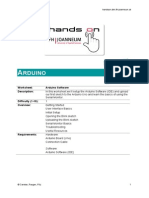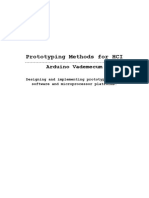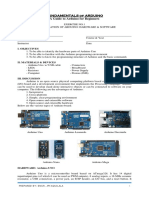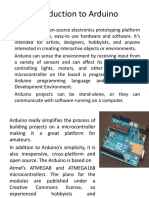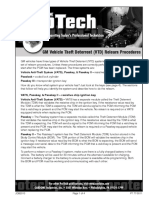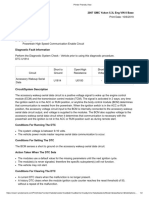Programming Arduino (1) Pages 32
Uploaded by
axl1994Programming Arduino (1) Pages 32
Uploaded by
axl19942
Getting Started
Having introduced the Arduino, and learned a little about what it is that we
are programming, it is time to learn how to install the software that we will need
on our computer and to start working on some code.
Powering Up
When you buy an Arduino board, it is usually preinstalled with a sample Blink
program that will make the little built-in light-emitting diode (LED) flash.
The LED marked L is wired up to one of the digital input output sockets on
the board. It is connected to digital pin 13. This does not mean that pin 13 can
only be used to light the LED; you can also use it as a normal digital input or
output.
All you need to do to get your Arduino up and running is supply it with some
power. The easiest way to do this is to plug it into the USB port on your
computer. You will need a type-A-to-type-B USB lead. This is the same type of
lead that is normally used to connect a computer to a printer.
If everything is working OK, the LED should blink. New Arduino boards
come with this Blink sketch already installed so that you can verify that the
board works.
Installing the Software
To be able to install new sketches onto your Arduino board, you need to do more
than supply power to it over the USB. You need to install the Arduino software
(Figure 2-1 ).
You might also like
- Drone Commercial pt107 Study Certification100% (2)Drone Commercial pt107 Study Certification13 pages
- AN Introductio Ntothe Arduino: Name: R.R.R.B.P.W.S.S.Palihawadan A Reg. No: 413338900No ratings yetAN Introductio Ntothe Arduino: Name: R.R.R.B.P.W.S.S.Palihawadan A Reg. No: 41333890013 pages
- Nyu Physical Computing Activity1 Act1gettingstarted v2 TedlNo ratings yetNyu Physical Computing Activity1 Act1gettingstarted v2 Tedl1 page
- Lecture 5 Course Project. Arduino Basics.: IAT267 Introduc:on To Technological SystemsNo ratings yetLecture 5 Course Project. Arduino Basics.: IAT267 Introduc:on To Technological Systems51 pages
- Basic Starter Kit For UNO V1.0.2017.7.9No ratings yetBasic Starter Kit For UNO V1.0.2017.7.983 pages
- Geekcreit Uno Ultimate Starter Kits TutorialNo ratings yetGeekcreit Uno Ultimate Starter Kits Tutorial139 pages
- Fundamentals of Arduino A Guide To Arduino For Beginners: I. ObjectivesNo ratings yetFundamentals of Arduino A Guide To Arduino For Beginners: I. Objectives8 pages
- Basic Starter Kit For MEGAV1.0.18.11.22No ratings yetBasic Starter Kit For MEGAV1.0.18.11.22115 pages
- Arduinocompiler: Embedded: Designing & Programming Using ArduinoNo ratings yetArduinocompiler: Embedded: Designing & Programming Using Arduino6 pages
- Arduino: The Ultimate Guide to Arduino for Beginners Including Arduino Basics, Tips & Tricks, Projects, and More!From EverandArduino: The Ultimate Guide to Arduino for Beginners Including Arduino Basics, Tips & Tricks, Projects, and More!No ratings yet
- GM Vehicle Theft Deterrent Relearn Procedures100% (1)GM Vehicle Theft Deterrent Relearn Procedures4 pages
- Cadillac Escalade 2003 - 2004 Fuse Box DiagramNo ratings yetCadillac Escalade 2003 - 2004 Fuse Box Diagram5 pages
- BD Torqueshift 6: Download The Latest Install Manuals at100% (1)BD Torqueshift 6: Download The Latest Install Manuals at17 pages
- Allison Transmission 1000 and 2000 Series Fault Codes List100% (1)Allison Transmission 1000 and 2000 Series Fault Codes List3 pages
- Amplifier Repair - How To Repair ElectronicsNo ratings yetAmplifier Repair - How To Repair Electronics6 pages
- Consumer Reports New Cars - December 2022 USA100% (4)Consumer Reports New Cars - December 2022 USA204 pages





























